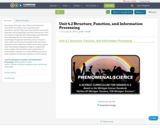
Conditional Remix & Share Permitted
CC BY-NC-SA
Description
Overview: Area: Plants and Animals
A central feature of life is that organisms grow, reproduce, and die. They have characteristic structures (anatomy and morphology), functions (molecular-scale processes to organism-level physiology), and behaviors (neurobiology and, for some animal species, psychology). Organisms and their parts are made of cells, which are the structural units of life and which themselves have molecular substructures that support their functioning. Organisms range in composition from a single cell (unicellular microorganisms) to multicellular organisms, in which different groups of large numbers of cells work together to form systems.
- Subject:
- Life Science
- Material Type:
- Unit of Study
- Date Added:
- 07/25/2019